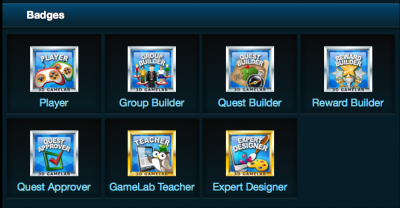 In both my reading of ROLE Reversal and learning how to use the 3D GameLab interface to gamify my classes the concept of student autonomy and choice is very important to create a student-centered experience. Kids need multiple pathways for learning and for demonstrating their learning. That needs to be balanced by the need for a scope and sequence. For example, in Science there are labs that we need to do as a whole class at the same time, in the same order, if only because it’s a nightmare setting up different labs for different kids at different times. Then keeping track of who’s learning what when you have a load of over 130 kids will become too daunting. So how do you balance giving kids choice as to what to study and when to study it vs the need to maintain some kind of pacing?
In both my reading of ROLE Reversal and learning how to use the 3D GameLab interface to gamify my classes the concept of student autonomy and choice is very important to create a student-centered experience. Kids need multiple pathways for learning and for demonstrating their learning. That needs to be balanced by the need for a scope and sequence. For example, in Science there are labs that we need to do as a whole class at the same time, in the same order, if only because it’s a nightmare setting up different labs for different kids at different times. Then keeping track of who’s learning what when you have a load of over 130 kids will become too daunting. So how do you balance giving kids choice as to what to study and when to study it vs the need to maintain some kind of pacing?
In game-based learning (GBL) I like the idea of whole class “Raids” for whole class, paced activities. Overall, I set the pace by keeping certain quest chains hidden until the prerequisite learning has happened. For example, kids won’t unlock the genetics unit until they’ve completed the mitosis/meiosis unit. At that point the whole class will be following a set of activities that will be offered to everyone all at once. Now there may be kids who are still working on the mitosis/meiosis quest chain or even some who are beginning it. At this point they all still get to participate in the whole class raid, the genetics intro inquiry activity lab even if they aren’t as ready as their comrades. Those who are ready will help their peers as they do in a regular, non-GBL class. Either way it has to happen because the genetics inquiry activity lab works best as a whole class lab. With regards to the follow up I will have smaller quests (activities) where the students have choice as to how they show what they got from the lab and share their data. It could be answering the questions in the textbook or it could be a follow up Internet research on the topic to see if their data was accurate. Just brainstorming here because kids like different things and some are comfortable with different things. Students at this point can even go back and finish their mitosis/meiosis quests. It will be up to the students. After whole group instruction or labs done in small groups it can left up to students whether they want to work in small groups or individually. It helps having a 1:1 environment for that.
Follow-up to labs isn’t the only concern, what about background knowledge before doing a lab as in the case of the students who weren’t done, or hadn’t really started, the mitosis/meiosis quests even though the rest of the class was ready for the genetics quests? I will offer multiple paths to having kids gain that background knowledge. Or let kids choose how they gain the background knowledge and their quest(s) won’t be approved until they can demonstrate they have the background knowledge. Even in a regular classroom there will be kids who don’t have the background knowledge even when we “teach” our butts off so I’m not too concerned here. My main goal with pre-lab activities is surfacing their preconceptions and see where we have to go from there. As long as all kids get to that, then they’ll at least get something out of the lab and I’ll have knowledge of where they were before the lab so I can see if the they progressed after the lab.
In ROLE Reversal by Mark Barnes he outlines strategies to develop a classroom where students are autonomous and in charge of their own learning, which seems to match what 3DGL does. I’m using Mark’s book to help me make my classes more student-centered. And using a gaming model with the 3DGL interface works well with a ROLE (Results Only Learning Environment) classroom. I’m willing to take the plunge and try it. I just haven’t planned it all out yet. So far I’m starting by preparing the 3DGL interface, building all the quests. Then I’ll figure out how to make it all a ROLE classroom. Thank goodness I have plenty of summer left!



















































